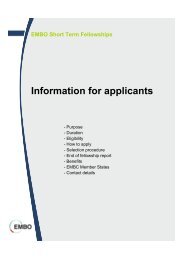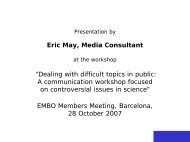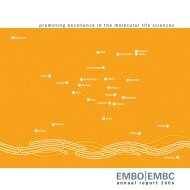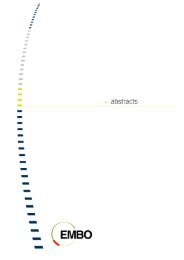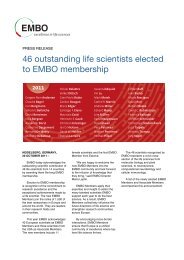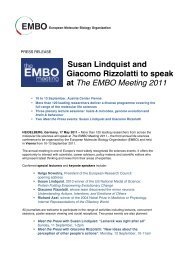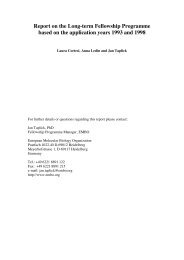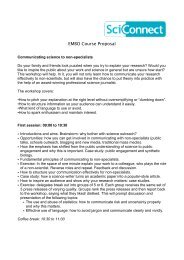EMBOencounters
EMBOencounters
EMBOencounters
Create successful ePaper yourself
Turn your PDF publications into a flip-book with our unique Google optimized e-Paper software.
cOMMENTARy<br />
Inside scientific publishing<br />
Scooping protection and rapid publication<br />
Earlier in the year, we started a series of articles<br />
in <strong>EMBOencounters</strong> to inform readers<br />
about some of the developments in scientific<br />
publishing. The previous article described the<br />
‘Transparent Review’ process used by The EMBO<br />
Journal, EMBO reports, Molecular Systems Biology<br />
and EMBO Molecular Medicine. It emphasized<br />
how the journals use referee cross-commenting to<br />
ensure informed and fair editorial decisions that<br />
are transparent and helpful for authors. It also<br />
explained the value of publishing referee reports<br />
alongside papers.<br />
All the EMBO papers where authors opted for<br />
this process are now marked with a diamond.<br />
These and other key procedures have been<br />
included in a formal description of The EMBO<br />
Transparent Publishing Process for all four EMBO<br />
publications (see Figure 1 and journal websites).<br />
Here, I describe the processes developed and<br />
used by the EMBO publications that allow<br />
authors to publish their best work fast, efficiently<br />
and without the constant concern of losing out to<br />
competitors.<br />
An important issue for authors in the<br />
biosciences is often pressure from competition<br />
with other research groups. Several components<br />
of The EMBO Transparent Publishing Process<br />
address this: a scooping protection policy, and<br />
10 Core Principles<br />
Single Round<br />
Manuscript Transfers<br />
Source Data<br />
Authors can elect to transfer<br />
manuscripts with referee reports<br />
between the EMBO publications.<br />
Authors can publish source data<br />
alongside figures. Supplementary<br />
information is restricted to essential<br />
data supporting key claims.<br />
Informed Evaluation<br />
Detailed editorial decisions<br />
supported by the Editorial Board.<br />
Authors can discuss manuscripts<br />
with editors at any stage in the<br />
process.<br />
Papers rarely undergo more<br />
than one major round of revision;<br />
more than 90% of invited<br />
revisions are published.<br />
Cite the Source<br />
TRANSPARENT<br />
PROCESS<br />
Reference to specific findings<br />
should cite the primary literature,<br />
not reviews. Journals have<br />
unlimited reference lists.<br />
Scooping Protection<br />
www.nature.com/emboj/about/process.html<br />
Similar findings published by<br />
others during review or revision<br />
are not a criterion for rejection.<br />
Fast Process<br />
Transparent Review<br />
Referee reports are published in<br />
full; no confidential comments;<br />
authors can exclude referees.<br />
Referee Cross-Commenting<br />
Referees comment on each other’s<br />
report before the editor makes<br />
a decision.<br />
Straightforward submission<br />
No journal-specific formatting is<br />
required at submission.<br />
Editorial decisions on average<br />
within a week, referee comments<br />
within a month, publication<br />
possible in 2 weeks.<br />
various steps to ensure rapid handling of the<br />
manuscript and to avoid protracted revisions.<br />
EMBO editors rapidly respond to submissions.<br />
The initial editorial decision ensures that only<br />
those manuscripts enter full peer review that<br />
have a high chance of acceptance in a timely<br />
manner, and referees are asked to judge the work<br />
that has been submitted, rather than to suggest<br />
what other experiments could have been done,<br />
or what follow-up work should be performed. If<br />
additional experimental evidence is required to<br />
support the claims, we request that referees focus<br />
on essential changes and consider the feasibility<br />
of the experiments that they suggest. Revisions<br />
are invited only if they are possible in a realistic<br />
time frame. Indeed, almost all of the manuscripts<br />
returned to authors for revision end up being<br />
published, usually within four months, which<br />
includes revision and publication time. Very few<br />
manuscripts undergo more than one major round<br />
of revision, as the editors request and monitor<br />
that referees do not raise new non-essential<br />
points after the first revision.<br />
It may happen during the course of the review<br />
process or during revision that a similar study<br />
appears elsewhere. At EMBO publications, similar<br />
findings published by others during review or<br />
revision are not a criterion for the rejection of a<br />
paper. This allows authors to receive the credit<br />
they deserve for the independent scientific findings<br />
reported. Note that while we suggest revision<br />
times these can be discussed with the editors<br />
– the overriding goal is to ensure time for thorough,<br />
essential revision.<br />
The EMBO Transparent Publishing Process<br />
helps ensure that excellent research can be<br />
shared with colleagues in a timely manner. It is<br />
the role of scientific journals to aid the scientific<br />
community, not to slow down research progress,<br />
and we hope that other journals will adopt similar<br />
strategies.<br />
Bernd Pulverer<br />
EMBO Head of Scientific Publications<br />
Further information on the EMBO<br />
Transparent Editorial Process is available at<br />
www.nature.com/emboj/about/process.html<br />
Figure 1<br />
The EMBO Transparent Publishing Process<br />
2 <strong>EMBOencounters</strong> | Autumn 2012 | communications@embo.org<br />
©2012 EMBO




